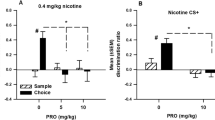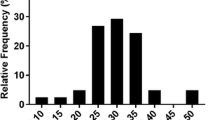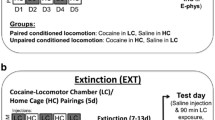Abstract
Rationale
The influence of persistent cocaine self-administration on learning and memory has never been evaluated.
Objectives
Our objective was to isolate the effects of contingently administered cocaine from those of its general pharmacological or non-contingent actions on multiple memory system functioning.
Methods
A triad design was used to yoke passive cocaine and saline administration to the behavior of rats who were actively self-administering cocaine. Following 4 weeks of cocaine or saline exposure in 2-h sessions, six triads were tested in the amygdala-dependent conditioned cue preference task and dorsal striatum-dependent win-stay task in an eight-arm radial maze environment. Drug or saline sessions continued throughout task testing.
Results
Throughout task testing, rats actively and passively exposed to cocaine sustained a total daily intake of approximately 15 mg/kg. During the conditioned cue preference task, saline-exposed rats showed robust conditioned preference for a Froot Loops-paired cue. Rats actively and passively exposed to cocaine showed no evidence of conditioning despite normal exploration in the maze during preference testing. For the win-stay task, no significant differences were found among the three groups in terms of the number of sessions to acquire the task or task accuracy at criterion. Rats actively or passively exposed to cocaine, however, completed sessions more quickly than saline-exposed rats at criterion.
Conclusion
These findings suggest that contingent and non-contingent cocaine administration similarly disrupt stimulus-reward functions of the amygdala, but do not disrupt stimulus-response functions of the dorsal striatum. This dissociation may relate to differences in the rate by which dopamine is cleared from these tissues following cocaine exposure or possibly to cocaine-induced devaluation of natural rewards, which influences stimulus-reward learning, but not stimulus-response learning.


Similar content being viewed by others
References
Allain H, Tessier C, Bentue-Ferrer D, Tarral A, Le Breton S, Gandon M, Bouhours P (2003) Effects of risperidone on psychometric and cognitive functions in healthy elderly volunteers. Psychopharmacology 165:419–429
Alleweireldt AT, Weber SM, Kirschner KF, Bullock BL, Neisewander JL (2002) Blockade or stimulation of D1 dopamine receptors attenuates cue reinstatement of extinguished cocaine-seeking behavior in rats. Psychopharmacology 159:284–293
Arnsten AF (1997) Catecholamine regulation of the prefrontal cortex. J Psychopharmacol 11:151–162
Bardo MT (1998) Neuropharmacological mechanisms of drug reward: beyond dopamine in the nucleus accumbens. Crit Rev Neurobiol 12:37–67
Baron SP, Wright D, Wenger GR (1998) Effects of drugs of abuse and scopolamine on memory in rats: delayed spatial alternation and matching to position. Psychopharmacology 137:7–14
Black YD, Green-Jordan K, Eichenbaum HB, Kantak (2003) Hippocampal memory system function and the regulation of cocaine self-administration behavior in rats. Behav Brain Res (in press)
Bradberry CW, Barrett-Larimore RL, Jatlow P, Rubino SR (2000) Impact of self-administered cocaine and cocaine cues on extracellular dopamine in mesolimbic and sensorimotor striatum in rhesus monkeys. J Neurosci 20:3874–3883
Ciccocioppo R, Sanna PP, Weiss F (2001) Cocaine-predictive stimulus induces drug-seeking behavior and neural activation in limbic brain regions after multiple months of abstinence: reversal by D(1) antagonists. Proc Natl Acad Sci U S A 98:1976–1981
Cutler AAR, Wilkerson AE, Gingras JL, Levin ED (1996) Prenatal cocaine and/or nicotine exposure in rats: preliminary findings on long-term cognitive outcome and genital development at birth. Neurotoxicol Teratol 18:635–643
DiPietro NC, Black YD, Green-Jordan K, Eichenbaum HB, Kantak KM (2002) Validation of a radial arm maze task to study lateral prefrontal cortex functions. Program No. 8.11. 2002 Abstracts Viewer/Itinerary Planner CD-ROM. Society for Neuroscience, Washington, DC
Dworkin SI, Smith JE (1989) Assessment of neurochemical correlates of operant behavior. In: Boulton A, Baker G, Greenshaw A (eds) Neuromethods, vol. 113. Humana Press, New Jersey, pp 741–786
Eichenbaum H, Cohen JN (2001) From conditioning to conscious recollection: memory systems of the brain. Oxford University Press, New York
Ettenberg A, Raven MA, Danluck DA, Necessary BD (1999) Evidence for opponent-process actions of intravenous cocaine. Pharmacol Biochem Behav 64:507–512
Floresco SB, Phillips AG (2001) Delay-dependent modulation of memory retrieval by infusion of a dopamine D1 agonist into the rat medial prefrontal cortex. Behav Neurosci 115:934–939
Floresco SB, Seamans JK, Phillips AG (1997) Selective roles for hippocampal, prefrontal cortical, and ventral striatal circuits in radial-arm maze tasks with or without a delay. J Neurosci 17:1880–1890
Fuchs RA, Weber SM, Rice HJ, Neisewander JL (2002) Effects of excitotoxic lesions of the basolateral amygdala on cocaine-seeking behavior and cocaine conditioned place preference in rats. Brain Res 929:15–25
Garris PA, Wightman RM (1995) Distinct pharmacological regulation of evoked dopamine efflux in the amygdala and striatum of the rat brain. Synapse 20:269–279
Grigson PS, Twining RC (2002) Cocaine-induced suppression of saccharin intake: a model of drug-induced devaluation of natural rewards. Behav Neurosci 116:321–333
Grilly DM, Gowans GC, McCann DS, Grogan TW (1989) Effects of cocaine and d-amphetamine on sustained and selective attention in rats. Pharmacol Biochem Behav 33:733–739
Hemby SE, Co C, Koves TR, Smith JE, Dworkin SI (1997) Differences in extracellular dopamine concentrations in the nucleus accumbens during response-dependent and response-independent cocaine administration in the rat. Psychopharmacology 133:7–16
Heyser CJ, Spear NE, Spear LP (1995) Effects of prenatal exposure to cocaine on Morris water maze performance in adult rats. Behav Neurosci 109:734–743
Hitchcott PK, Phillips GD (1998) Double dissociation of the behavioural effects of R-(+)-7-OH-DPAT infusions in the central and basolateral amygdala nuclei upon Pavlovian and instrumental conditioned appetitive behaviors. Psychopharmacology 140:458–469
Hitchcott PK, Harmer CJ, Phillips GD (1997) Enhanced acquisition of discriminative approach following intra-amygdala d-amphetamine. Psychopharmacology 132:237–246
Howes SA, Dalley JW, Morrison CH, Robbins TW, Everitt BJ (2000) Leftward shift in the acquisition of cocaine self-administration in isolation-reared rats: relationship to extracellular levels of dopamine, serotonin and glutamate in the nucleus accumbens and amygdala-striatal FOS expression. Psychopharmacology 151:55–63
Hurd YL, McGregor A, Ponten M (1997) In vivo amygdala dopamine levels modulate cocaine self-administration behaviour in the rat: D1 dopamine receptor involvement. Eur J Neurosci 9:2541–2548
Ito R, Dalley JW, Howes SR, Robbins TW, Everitt BJ (2000) Dissociation in conditioned dopamine release in the nucleus accumbens core and shell in response to cocaine cues and during cocaine-seeking behavior in rats. J Neurosci 20:7489–7495
Ito R, Dalley JW, Howes SR, Robbins TW, Everitt BJ (2002) Dopamine release in the dorsal striatum during cocaine-seeking behavior under the control of a drug-associated cue. J Neurosci 22:6247–6253
Jones SR, Garris PA, Kilts CD, Wightman RM (1995) Comparison of dopamine uptake in the basolateral amygdaloid nucleus, caudate-putamen, and nucleus accumbens of the rat. J Neurochem 64:2581–2589
Kalivas PW, Duffy P, DuMars LA, Skinner C (1988) Behavioral and neurochemical effects of acute and daily cocaine administration in rats. J Pharmacol Exp Ther 245:485–492
Kantak KM, Collins SL, Lipman EG, Bond J, Giovanoni K, Fox BS (2000) Evaluation of anti-cocaine antibodies and a cocaine vaccine in a rat self-administration model. Psychopharmacology 148:251–562
Kantak KM, Green-Jordan K, Valencia E, Kremin T, Eichenbaum HB (2001) Cognitive task performance after lidocaine-induced inactivation of different sites within the basolateral amygdala and the dorsal striatum. Behav Neurosci 115:589–601
Kantak KM, Black Y, Valencia E, Green-Jordan K, Eichenbaum HB (2002a) Dissociable effects of lidocaine-inactivation of the rostral and caudal basolateral amygdala on the maintenance and reinstatement of cocaine-seeking behavior in rats. J Neurosci 22:1126–1136
Kantak KM, Black Y, Valencia E, Green-Jordan K, Eichenbaum HB (2002b) Stimulus-response functions of the dorsal striatum and regulation of behavior studied in a cocaine maintenance/cue reinstatement model in rats. Psychopharmacology 161:278–287
Kimberg DY, D’Esposito M (2003) Cognitive effects of the dopamine receptor agonist pergolide. Neuropsychologia 41:1020–1027
Kimberg DY, D’Esposito M, Farah MJ (1997) Effects of bromocriptine on human subjects depend on working memory capacity. Neuroreport 8:3581–3585
Kuzmin A, Johansson B (1999) Expression of c-fos, NGFI-A and secretogranin II mRNA in brain regions during initiation of cocaine self-administration in mice. Eur J Neurosci 11:3694–3700
Lau CE, Sun L (2002) The pharmacokinetic determinants of the frequency and pattern of intravenous cocaine self-administration in rats by pharmacokinetic modeling. Drug Metab Dispos 30:254–261
Ledford CC, Fuchs RA, See RE (2003) Potentiated reinstatement of cocaine-seeking behavior following d-amphetamine infusion into the basolateral amygdala. Neuropsychopharmacology 28:1721–1729
Lett BT (1989) Repeated exposures intensify rather than diminish the rewarding effects of amphetamine, morphine, and cocaine. Psychopharmacology 98:357–362
Levin ED, Seidler FJ (1993) Sex-related spatial learning differences after prenatal cocaine exposure in the young adult rat. Neurotoxicology 14:23–28
Marshall JF, O’Dell SJ, Navarrete R, Rosenstein AJ (1990) Dopamine high-affinity transport site topography in rat brain: major differences between dorsal and ventral striatum. Neuroscience 37:11–21
McDonald RJ, White NM (1993) A triple dissociation of memory systems: hippocampus, amygdala, and dorsal striatum. Behav Neurosci 107:3–22
Melnick SM, Kubie JL, Laungani R, Dow-Edwards DL (2001) Impairment of spatial learning following preweaning cocaine exposure in the adult rat. Neurotoxicol Teratol 23:445–451
Packard MG, White NH (1989) Memory facilitation produced by dopamine agonists: role of receptor subtype and mnemonic requirements. Pharmacol Biochem Behav 33:511–518
Packard MG, White NH (1991) Dissociation of hippocampus and caudate nucleus memory systems by posttraining intracerebral injection of dopamine agonists. Behav Neurosci 105:295–306
Peretti CS, Danion JM, Kauffmann-Muller F, Grange D, Patat A, Rosenzweig P (1997) Effects of haloperidol and amisulpride on motor and cognitive skill learning in healthy volunteers. Psychopharmacology 131:329–338
Phillips GD, Setzu E, Vugler A, Hitchcott PK (2003) Immunohistochemical assessment of mesotelencephalic dopamine activity during the acquisition and expression of Pavlovian versus instrumental behaviours. Neuroscience 117:755–767
Quirk PL, Richards RW, Avery DD (2001) Subchronic cocaine produces training paradigm-dependent learning deficits in laboratory rats. Pharmacol Biochem Behav 68:545–553
Robbins TW (2002) The 5-choice serial reaction time task: behavioural pharmacology and functional neurochemistry. Psychopharmacology 163:362–389
Sage JR, Knowlton BJ (2000) Effects of US devaluation on win-stay and win-shift radial maze performance in rats. Behav Neurosci 114:295–306
See RE, Kruzich PJ, Grimm JW (2001) Dopamine, but not glutamate, receptor blockade in the basolateral amygdala attenuates conditioned reward in a rat model of relapse to cocaine-seeking behavior. Psychopharmacology 154:301–310
Shimosato K, Ohkuma S (2000) Simultaneous monitoring of conditioned place preference and locomotor sensitization following repeated administration of cocaine and methamphetamine. Pharmacol Biochem Behav 66:286–292
Tonkiss J, Shultz PL, Shumsky JS, Galler JR (1997) Development of spatial navigation following prenatal cocaine and malnutrition in rats: lack of additive effects. Neurotoxicol Teratol 19:363–372
Vitiello B, Martin A, Hill J, Mack C, Molchan S, Martinez S, Murphy DL, Sunderland T (1997) Cognitive and behavioral effects of cholinergic, dopaminergic, and serotonergic blockage in humans. Neuropsychopharmacology 16:15–24
Vorhees CV, Inman-Wood SL, Morford LL, Reed TM, Moran MS, Cappon GD (2000) Evaluation of neonatal exposure to cocaine on learning, activity, startle, scent marking, immobility, and plasma cocaine concentrations. Neurotoxicol Teratol 22:255–265
Wayment HK, Schenk JO, Sorg BA (2001) Characterization of extracellular dopamine clearance in the medial prefrontal cortex: role of monoamine uptake and monoamine oxidase inhibition. J Neurosci 21:35–44
Wilson JM, Nobrega JN, Corrigall WA, Coen KM, Shannak K, Kish SJ (1994) Amygdala dopamine levels are markedly elevated after self- but not passive-administration of cocaine. Brain Res 30:39–45
Yin HH, Knowlton BJ (2002) Reinforcer devaluation abolishes conditioned cue preference: evidence for stimulus-stimulus associations. Behav Neurosci 116:174–177
Zahrt J, Taylor JR, Mathew RG, Arnsten AF (1997) Supranormal stimulation of D1 dopamine receptors in the rodent prefrontal cortex impairs spatial working memory performance. J Neurosci 17:8528–8535
Acknowledgements
This research was supported by the National Institute on Drug Abuse grant DA 11716.
Author information
Authors and Affiliations
Corresponding author
Rights and permissions
About this article
Cite this article
Udo, T., Ugalde, F., DiPietro, N. et al. Effects of persistent cocaine self-administration on amygdala-dependent and dorsal striatum-dependent learning in rats. Psychopharmacology 174, 237–245 (2004). https://doi.org/10.1007/s00213-003-1734-1
Received:
Accepted:
Published:
Issue Date:
DOI: https://doi.org/10.1007/s00213-003-1734-1




